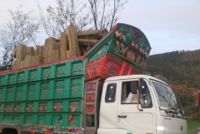PAKISTAN: Forests Fall Victim to the Taliban

The forests of northwestern Pakistan have become the latest victim of the Taliban’s increasingly desperate quest for resources to sustain and fund its military programme.
The landscape of Swat, an administrative district in the Khyber Pakhtunkhwa Province and once a luscious valley, is now dotted with thousands of tree stumps as militants decimate acres of forest for timber revenues.
'Nearly all the forested areas have been mercilessly stripped of trees but the Swat in particular has borne the brunt of the Taliban’s atrocities over the last two years,' Jamshaid Ali Khan, secretary of the Sarhad Awami Forestry Ittehad (SAFI), told IPS.
SAFI was founded in 1997 in the hopes of conserving, managing and developing forests, providing income for local workers, reducing air pollution and minimising soil erosion during floods but its operations were severely restricted between 2007 and 2009, when the Taliban exercised full control over Swat.
Despite all its best efforts, the organisation has failed to stop the lopping of trees to fund the Islamic movement. Jamshaid lamented the Taliban’s tactic of enlisting the services of the ‘timber mafia’ to fell forests and sell the wood for throwaway prices.
Rahim Gul, a researcher at the University of Peshawar, says the Taliban frequently ‘clean their hands’ on natural resources, whenever they are short of funds.
'The Taliban finance their movement by (extracting timber) or imposing harsh taxes on the transportation of marbles from the northern Federally Administered Tribal Areas (FATA),' he said, adding that the Taliban’s crude methods of tree cutting cause permanent damage to the environment.
'A tree takes 100 years to mature before it can be cut for construction wood. The government cuts the trees after evaluation and planting sapling as substitutes,' Jamshaid said. The majority of trees felled by the Taliban have not yet reached their full state of maturity, he said. Citing research conducted by the Pakistan Forest Institute of Peshawar, Gul claimed that the Taliban also employs methods such as kidnapping for ransom, growing poppy crops and harbouring criminals as income-generating schemes. They also mine and sell precious stones, including fine quality emeralds.
However, timber extraction remains the most popular, and arguably most destructive, activity by far.
Wide-scale deforestation
Mohammad Jawad, a forest officer for the Khyber Pakhtunkhwa, explained that before the onset of militancy in 2005, the province accounted for 40 percent of the country’s forest resources.
Although no fresh research has been done since, 'it is largely believed that the Taliban have destroyed 80 percent of those forests,' he said.
The Malaknd Division of northwestern Pakistan, renowned for its vast expanses of pine, dewdar, cedar and byar trees, now wears a deserted look.
'Fewer forests mean less money for the more than 20,000 households in Swat and adjacent districts in the Malaknd Division, all of which considered the forests to be their ‘lifeline’, since it provided them an income and royalties from the sale of trees,' he added.
Ameer Muhammad Khan of SAFI told IPS that local communities had traditionally relied on forests for firewood, construction wood and grazing pastures.
'The government is responsible for protecting these forests but it has no authority to stop the Taliban from the ruthless laceration that has deprived 80,000 people of royalties from the sustainable sale of trees,' he stressed.
According to SAFI, every resident of the forest-rich areas of Malaknd used to receive about 100 dollars in annual royalties before the Taliban’s onslaught against the forests began but now that amount has plunged to just 10 dollars. People are cursing the Taliban for bringing about such a swift cut to their meagre income.
Not only the residents of Malaknd but the government too has suffered losses of up to 350 million dollars according to a report by the Forest Development Corporation.
Khyber Pakhtunkhwa Forest Minister Wajid Ali Khan told IPS that his ministry had launched a programme aimed at mobilising local communities to plant more trees and hopefully make up for the losses wrought by the Taliban.
'We have also begun consultations with lawmakers, bureaucrats, local communities and the media to promote good plantation habits in the affected areas,' he said.
The programme further seeks to mobilise, organise and empower forest owners, rights holders (anyone owed royalties from the sale of government-owned trees) and non-owners in order to influence policy reforms, the minister added.
'We have embarked on reforms in collaboration with the rights holders to carry out plantation drives and prevent further cutting of trees. More than 20 forest checkpoints have been established, which are managed by the local communities in collaboration with the government,' he said.
SAFI is also asking the government to enhance royalties, since the militancy has damaged local business.
Forest-dependent communities are the hardest-hit victims of the Taliban’s tirade against forests, which has also caused enormous damage to the entire forest ecosystem, necessitating integrative and interactive methods such as farm forestry.
'To promote farm forestry we have distributed 1.5 million plants among the local residents,' Jamshaid told IPS.
SAFI also planted 100,000 saplings on 2000 acres of land in Malaknd after the Taliban’s defeat in 2009.
In another effort to counteract the effects of rampant deforestation, SAFI hosts an annual People’s Forest Assembly, where methods of conservation and management are discussed, Ameer Muhammad Khan told IPS.
Yet Jamshaid warned a lot more needs to be done to create an environment conducive to sustainable and participatory forest management.
Militants have not only deforested the Malaknd district but also felled 6,000 acres of forest in the surrounding region. Abdul Rasool, a forest officer at the FATA secretariat, told IPS that the militants have so far chopped down roughly 50,000 big trees.
Of the Malaknd’s seven districts the Swat, Dir and Buner have suffered the most; their hills, which used to be covered with tall trees, now stand deserted.
© Inter Press Service (2012) — All Rights ReservedOriginal source: Inter Press Service
 Global Issues
Global Issues